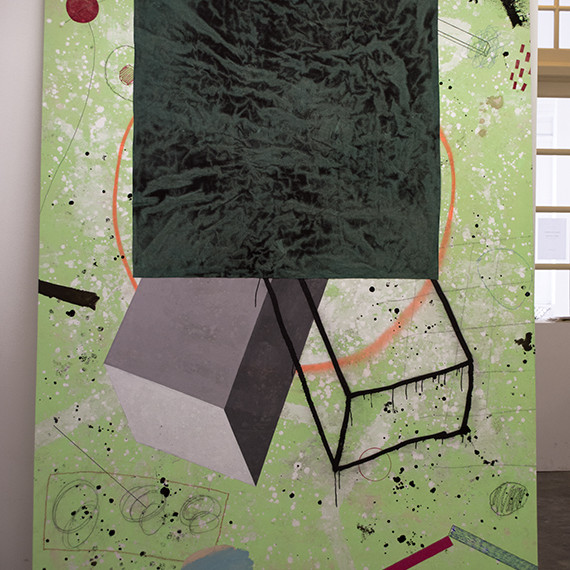BLOOD & MEMORY / ELEMENT ART SPACE / 2014
Asian artist Volkan Diyaroğlu was born on the shores of the Black Sea, a sea sailed thousands of times by the kinsmen of the poet Hesiod, who bequeathed to us the knowledge of what in the beginning was Chaos, Chaos that was subjected to the ordering of Time, whose lovechild and incestuous mother of the Muses of all arts is Mnemosyne, the personification of Memory.
The clean origin of Memory says a lot to her credit, yet it is her genesis from an incestuous relationship (remember that the Muses are the daughters of Mnemosyne and her father, Zeus, who visited her every night for nine nights) that helps us better understand the nature of the arts; that is why all is valid in art; everything, as long as the result warrants it; we are not concerned with the processes, the media or the materials used to forge the work, if I can feel her in my gut, if she moves inside me and chooses to reside there for a spell.
In the case of painter , this is taken to an extreme, as his painting is absolutely corporal and unmeditated, so much so that we might say that he paints with his feet, because he always faces the canvas from a zenithal perspective (from Olympus, according to the tradition from whence he derives), and everything that passes through his head is limited by strict margins (order) imposed by his feet. This painting with his feet is a corporeal sort of painting; because if he painted with his hands, he would do so on an easel and the result would be completely different, and most importantly, it would take away the impetus to transfer the impression to his mind; it being a painting that is limited by blinders (the blinders of his shoes), it is unwittingly transformed into a tryst on canvas, revealing traces, forms, gestures, randomness, findings, geometries and the superposition of things that seem to have stuck to his hands, drenched as they are in wet paint. He paints so quickly that the Memory has no time to dry, and thus it all sticks; whatever he happens or stumbles upon or steps on as he moves back and forth to get it all ready. He runs through the studio, coming and going, in an attempt to escape those unruly feet that, while limiting his vision, do not impede him from continuing to think from a head that is unaware of where it is.
In the beginning there was Chaos.
In the beginning was everything inside his head? But where? He thinks.
He comes and goes through space; he climbs and falls through his ideas; he remembers, projects, revises, attempts. He traces geometries from the same space that is his body, yearning to impose his presence by presenting himself in solid form, as a hexahedron, imposing, as if it were an architectural mass (architecture is the strict extension of our body, and the attempt to organise nature, from inside our head, according to the laws of man); but the head returns to the beginning and wants to take sides.
Fine, he lets it reckon for a while.
Order is imposed and pathways are gradually established to reach the end of the painting, because this painter, like all painters, aims to finish the painting at all cost, even through sweat and blood, spilt on the canvas, if it comes to that. At that moment the head reaches an agreement with the rest of his body and allows the blood flow to sort everything out, but of course, once everything seemed to be back in place, he discovers that blood is Chaos in the strictest form; back to the dialectic, in the presence of which there is no solution, as many of the paintings which we will encounter here, each of them cosmic (product of the cosmogony that they attempt to describe) have constructed a chaosmic hemisphere that emerges with a tremendous force from the painting, because (the painter thinks on the inside) if Memory now resides only inside our computers, in its circuit boards, outside is chaos, and only one response of resistance can be had: against the stamped (printed), the unique (painting) and original (cosmic).
Thus the painting presented here, in appearance, is both Memory and testimony. Memory, when it calls up the very history of the author’s own trajectory, through the introduction of remnants of his past work (his followers can trace the passages of his artistic itinerary in many of the paintings on exhibition here and revisit very significant moments in his art). Testimony, as the receiver of the objects that wander around his studio, a record of the precise moment in which the paintings were created, because painting is timeless, but the things imposed on canvas are from the exact Time when they were cast onto it and attempt to serve as an anchor to reality and proclaim that in the midst of so much Chaos, a door can exist that helps us transcend it.
In the end, however, it all turns into blood spurting from the brushes of an artist through whom litres upon litres of paint flow, leaving the cosmic in ruins; all by following a strict regimen of painting with his feet so that his hands do not govern his head. And thus, without making heads or tails of it, he inaugurates chaosmic painting.
nilo casares





